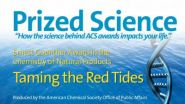(Press-News.org) People who watch funny videos on the internet at work aren't necessarily wasting time. They may be taking advantage of the latest psychological science—putting themselves in a good mood so they can think more creatively.
"Generally, positive mood has been found to enhance creative problem solving and flexible yet careful thinking," says Ruby Nadler, a graduate student at the University of Western Ontario. She and colleagues Rahel Rabi and John Paul Minda carried out a new study published in Psychological Science, a journal of the Association for Psychological Science. For this study, Nadler and her colleagues looked at a particular kind of learning that is improved by creative thinking.
Students who took part in the study were put into different moods and then given a category learning task to do (they learned to classify sets of pictures with visually complex patterns). The researchers manipulated mood with help from music clips and video clips; first, they tried several out to find out what made people happiest and saddest. The happiest music was a peppy Mozart piece, and the happiest video was of a laughing baby. The researchers then used these in the experiment, along with sad music and video (a piece of music from Schindler's List and a news report about an earthquake) and a piece of music and a video that didn't affect mood. After listening to the music and watching the video, people had to try to learn to recognize a pattern.
Happy volunteers were better at learning a rule to classify the patterns than sad or neutral volunteers. "If you have a project where you want to think innovatively, or you have a problem to carefully consider, being in a positive mood can help you to do that," Nadler says. And music is an easy way to get into a good mood. Everyone has a different type of music that works for them—don't feel like you have to switch to Mozart, she says.
Nadler also thinks this may be a reason why people like to watch funny videos at work. "I think people are unconsciously trying to put themselves in a positive mood"—so that apparent time-wasting may actually be good news for employers.
###
The APS journal Psychological Science is the highest ranked empirical journal in psychology. For a copy of the article "Better Mood and Better Performance: Learning Rule Described Categories Is Enhanced by Positive Mood" and access to other Psychological Science research findings, please contact Keri Chiodo at 202-293-9300 or kchiodo@psychologicalscience.org.
A positive mood allows your brain to think more creatively
2010-12-16
ELSE PRESS RELEASES FROM THIS DATE:
Protein disables p53, drives breast cells toward cancer transition
2010-12-16
HOUSTON - The recently identified TRIM24 protein plays an active role in pushing normal breast cells into rapid cell proliferation and, potentially, into breast cancer.
Reporting in the journal Nature, a team led by researchers at The University of Texas MD Anderson Cancer Center found that TRIM24 (tripartite motif-containing 24) pushes estrogen-responsive genes toward active expression. This expression, in turn, sets the stage for malignant transformation of breast cells. TRIM24 functions by reading a specific code, or signature, present at estrogen-regulated genes and ...
Elevated zinc concentrations in Colorado waterway likely a result of climate change
2010-12-16
Rising concentrations of zinc in a waterway on Colorado's Western Slope may be the result of climate change that is affecting the timing of annual snowmelt, says a new study led by the University of Colorado at Boulder.
The study focused on the Snake River watershed just west of the Continental Divide near Keystone, Colo., where CU-Boulder researchers have observed a four-fold increase in dissolved zinc over the last 30 years during the lowest water flow months, said Caitlin Crouch. Crouch, a master's degree student who led the study, said the high levels of zinc affect ...
Study improves understanding of method for creating multi-metal nanoparticles
2010-12-16
A new study from researchers at North Carolina State University sheds light on how a technique that is commonly used for making single-metal nanoparticles can be extended to create nanoparticles consisting of two metals – and that have tunable properties. The study also provides insight into the optical properties of some of these nanoparticles.
Tuning the optical properties of nanoparticles is of interest for applications such as security technology, and for use in making chemical reactions more efficient – which has multiple industrial and environmental applications. ...
New American Chemical Society Prized Science video on 'red tide' shellfish poisoning
2010-12-16
WASHINGTON, Dec. 15, 2010 — The quest to cure a terrible form of food poisoning caused by population explosions of algae that stain the water red and produce a potent toxin is the topic of a new episode in the American Chemical Society (ACS) Prized Science video series.
Entitled "Taming the Red Tides," the high-definition video, released today, focuses on Michael Crimmins, Ph.D., winner of the 2010 Ernest Guenther Award in the Chemistry of Natural Products. Crimmins, a chemist at the University of North Carolina in Chapel Hill, studies brevetoxin A, a poison produced ...
Study supports gluten-free diet in potential celiac disease patients
2010-12-16
Findings from a new study of 141 adults add to an ongoing medical debate over which patients with symptoms of celiac disease should go on a gluten-free diet. Published in ACS' Journal of Proteome Research, the study concludes that people currently diagnosed as "potential" celiac disease patients and not advised to follow a gluten-free diet may not be "potential" patients at all. Rather, the scientists found that these patients have the same distinctive metabolic fingerprint as patients with full-blown disease who do benefit from gluten-free diets.
In the study, Ivano ...
Does fluoride really fight cavities by 'the skin of the teeth?'
2010-12-16
In a study that the authors describe as lending credence to the idiom, "by the skin of your teeth," scientists are reporting that the protective shield fluoride forms on teeth is up to 100 times thinner than previously believed. It raises questions about how this renowned cavity-fighter really works and could lead to better ways of protecting teeth from decay, the scientists suggest. Their study appears in ACS' journal Langmuir.
Frank Müller and colleagues point out that tooth decay is a major public health problem worldwide. In the United States alone, consumers spend ...
Toxic toy crisis requires fresh solutions
2010-12-16
Manufacturer recalls of toys, promotional drinking glasses, and other children's products constitute an ongoing "toxic toys crisis" that requires banning potentially harmful ingredients in these products and other changes in policy and practices. That's the conclusion of a new analysis in ACS' journal Environmental Science & Technology.
Monica Becker, Sally Edwards and Rachel Massey note that in June the United States government recalled 12 million promotional drinking glasses sold at a fast-food restaurant chain because the painted coating contained cadmium, a toxic ...
Preteen conduct problems leads to teenage serious violence and delinquency
2010-12-16
Montreal, December 15, 2010 – Conduct disorders in preteens are predictive of eventual teenage serious violent and delinquent behavior, according to a new study from the Université de Montréal. The findings, published in this month's issue of Journal of Child Psychology and Psychiatry, have implications for concerned parents.
Preteens who steal, destroy property, fight and bully are six times as likely to sell illicit drugs, nine times as likely to join a gang, 11 times as likely to carry a weapon and eight times as likely to be arrested as a future teenager, according ...
Cilantro ingredient can remove foul odor of holiday chitlins
2010-12-16
With chitlins about to make their annual appearance on Christmas and New Year's Day menus, scientists have good news for millions of people who love that delicacy of down-home southern cooking, but hate the smell. They are reporting the first identification of an ingredient in cilantro that quashes the notoriously foul odor of chitlins — a smell known to drive people from the house when chitlins are cooking. Their report appears in ACS' Journal of Agricultural and Food Chemistry.
Yasuyoshi Hayata and colleagues note that chitlins — hog large intestines — are infamous ...
Bacterial life on and in humans orchestrates health and disease
2010-12-16
A mounting tide of scientific evidence suggests that the old adage from Aesop's fables — "You are known by the company you keep" — also applies to the trillions of microscopic bacteria and viruses that live on the human body. Humanity's invisible but constant companions — more bacteria hang out on the palms of your hands than there are people on Earth — is the topic of an article in the current edition of Chemical & Engineering News (C&EN), ACS' weekly newsmagazine.
C&EN Associate Editor Sarah Everts notes in the article that the astonishing diversity of microbes inhabiting ...


